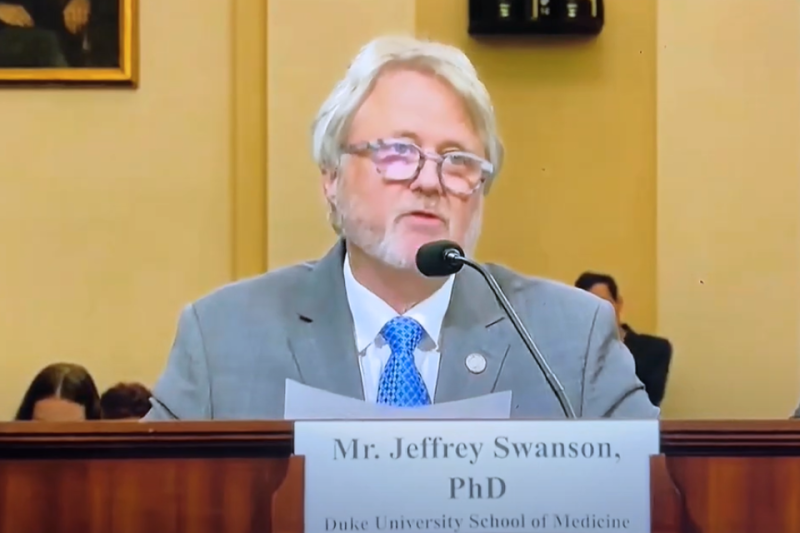
On July 18, Jeffrey Swanson, PhD, provided testimony to the Full Committee Legislative Hearing on H.R. 705 (Veterans Second Amendment Protection Act), U.S. House of Representatives Committee on Veterans Affairs. Swanson has conducted research on gun violence for decades. Below is his testimony, followed by the video of his testimony and questioning.
Good morning, Chairman Bost, Ranking Member Takano, and Members of the Committee.
A challenging policy dilemma underlies arguments for and against the proposed Veterans Second Amendment Protection Act. On the one hand, private ownership of firearms is a constitutionally protected individual right that is especially cherished by many U.S. military veterans; as a group, veterans are twice as likely to own a firearm as the general population. On the other hand, veterans are dying—every single day—by suicide with firearms, in numbers exceeding the toll of those who perished in war. Each is a preventable tragedy of immense human cost.
Suicide is the second leading cause of death in veterans, who are 57% more likely to die by suicide than non-veteran adults, and veterans’ greater access to firearms plays a key role in their increased risk of suicide. Veterans are far more likely than non-veterans to use guns—the most lethal method—in suicide attempts. Approximately one in five gun suicides in the U.S. is a military veteran.
Is it better for the law to err on the side of preserving the second amendment right for more veterans, even if it means that some will die preventable deaths? Or is it better to err on the side of saving more lives, at the cost of restricting the gun rights of some veterans who would not have died by suicide anyway?
So a key policy question is, how do we find the right balance between mitigating risk and upholding rights in designing and implementing legal restrictions of veterans’ access to firearms? No firearm-restriction policy is perfect and there will always be errors made in its application to individuals: false positives and false negatives. Is it better for the law to err on the side of preserving the second amendment right for more veterans, even if it means that some will die preventable deaths? Or is it better to err on the side of saving more lives, at the cost of restricting the gun rights of some veterans who would not have died by suicide anyway?
Wherever the lines are drawn to mark out a category of people deemed sufficiently risky to override their second amendment right, we should assure that due process protections and opportunities for appeal are sufficiently robust to offer a meaningful and not-overly burdensome chance for individuals to contest their deprivation before an independent judicial authority or administrative officer acting in such capacity in a hearing. On that score, the current policy might be seen as a work in progress.
We cannot know precisely each individual’s likelihood of harming others or self with a gun; we know that some categories of people are generally associated with relatively higher risk. One such category comprises VA beneficiaries found incompetent to manage their VA benefits. The statistical evidence for this is indirect. It would be most informative to bring direct evidence to bear, by studying the actual population of veterans with fiduciaries—to quantify their concentration of risk factors for dangerous behavior, and examine their specific suicide mortality rate with and without firearm involvement. Such a study has not yet been conducted.
In the meantime, our research group carried out a study designed to estimate risk of suicidal behavior and interpersonal violence in veterans who are most likely to be assigned a fiduciary. We analyzed data on 3,200 post-deployment veterans from the Iraq and Afghanistan war era. We constructed three separate indicators of need for a fiduciary in these data— based on cognitive performance, substance use disorder, and acute psychopathology. We found that all three of these proxies for fiduciary assignment were statistically-significantly correlated with suicidal symptoms and interpersonal violence. This third indicator identified a small group of veterans who were, on average, eight times more likely than other veterans to have suicidal symptoms and to have engaged in violence.
In summary, our research provided evidence consistent with a public-safety rationale for the policy of fiduciary NICS reporting. However, I have also concluded that a somewhat analogous civilian policy of reporting incompetent Social Security Beneficiaries to the NICS was not warranted; it was overbroad, not supported by evidence, and lacked due process.
Policies that restrict access to firearms for people who pose a high risk of harming others or themselves can and do save lives. But in this country, such policies need to find the right balance between mitigating risk and preserving rights. The current VA policy of reporting to the NICS the names of veterans who are assigned fiduciaries is not perfect. It could be improved, especially if guided by more research evidence.
But in the meantime, it seems unwise to simply scrap the reporting policy that has been in place for decades without having something better to put in its place.
In closing, I have a personal interest in this as well. My late father, a gun owner who served honorably in the United States Navy in the 1940s, was deemed incompetent by the VA toward the end of his life. I was his fiduciary, and I understood clearly why he should not have access to guns. I have also lost three members of my extended family to gun-related suicides. Each of them was a preventable tragedy that caused immense suffering for their families and friends.
I am happy to take your questions and to provide any further assistance that might help the Committee in making this important decision.
Below is the video of Swanson's testimony and questioning. Read more about the hearing in this NC Newsline article.